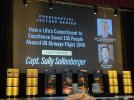32 hours TT in that aircraft- of which 6.4/6.4/9.1 hours 30/60/90 days.
So, we often hear that flight time is quite restricted in today's military. They also have sophisticated simulators to be able to spend a minimum of time on the aircraft, plus very comprehensive ground training. The hours seen in the military do not in any way match up to what we as civilians would expect.
@35 AoA and any other active military fliers, how much time does one get into an active fighter jet type with these days? I believe they're requiring Private to be completed beforehand now and/or using cheap aircraft and 3rd-party training providers for initial training, but I'm guessing that there's still some rules in place that wash people out during that phase - Is the 10-hour solo still a thing? Do they get more than 50 for initial VFR training or 100 with IFR included? Are they sticking zero-time people into T-6As, or just using those for maneuvers after the primary and instrument training is complete? How much time is spent in a T-38 before one jumps into an F-16, F-22, or F-35?
And, once in one of those front-line fighters, how much time do they normally get in 30/90 days?
Not that it's necessarily analogous, but both with my own HP piston aircraft and when I had a combo desk/flying job, 3 weeks seems to be the dividing line - If I have flown in the last 3 weeks, everything goes smoothly. If it's been more than 3 weeks, I'm OK but I can tell that I'm not completing flows as quickly or smoothly, and things don't seem quite so automatic as they otherwise would.
6.4 hours in the last 30 is presumably more than one sortie, but no hours in the previous 30 might indicate that more flying should be happening.
This reminds me of the F-16 accident at Shaw in 2020. Pilot was a qualified F-16 pilot, but was working through mission qualification training in advance of a deployment. They stuck him on a crazy training sortie with another new pilot and two instructors as their wingmen. Their first task was to do his first ever aerial refueling, followed by his first simulated enemy air defense suppression, all at night. Of course the pilot is going to feel pressure to get everything done in time to deploy... There was some IMC, tanker had to change altitudes, the instructors were able to refuel successfully, the other student had some trouble but finally got it, and the pilot was unable to refuel. So, the remainder of the mission had to be scrubbed for him and his instructor/wingman, they flew back to base, shot an ILS, and upon transitioning to visual the pilot maneuvered down to a lower glidepath which I guess is normal, but instead of aiming at the threshold he misinterpreted the lights (again, very limited night experience) and hit the localizer antennae with his main landing gear, causing damage. He successfully went around, but some other failures occurred with the personnel supporting him at that point that caused them to run an incorrect checklist and decide on a cable-arrested landing even though the pilot questioned that twice (he was correct). The hook skipped over the cable, the wing dropped, the pilot ejected, and then the ejection seat sequencer failed and his parachute failed to open, so he took a ballistic ride on the seat and died upon impact. LOTS of stuff going wrong, and I think they said the pilot had only 8 hours in the last month and under 100 total time in type.
I also had no idea how many military aviators are killed. 59 over the past 10 calendar years, and 10 more so far this year. RIP.


 www.twz.com
www.twz.com



